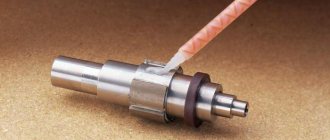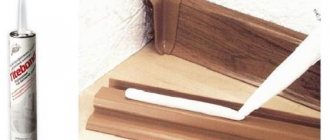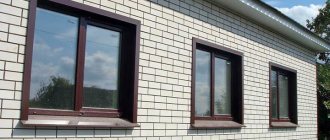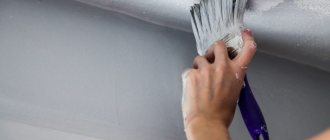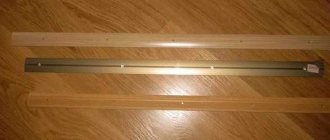One of the most popular types of flooring is linoleum. This material is not difficult to install and maintain, is comfortable to use, and does not require replacement for a long time. At the same time, the attractive appearance and long service life of linoleum require proper installation from the very beginning. During the installation process, you should ensure, among other things, that the individual panels are correctly joined together. Here we will tell you in detail how this is done.
How and with what to hide linoleum joints
Is linoleum intended for a concrete or wood base?
Linoleum can be laid on concrete. However, this is only if there are no depressions, bumps or noticeable differences in height on the base. All this then begins to protrude, to avoid which you need to level the floor before laying the covering on it. Self-leveling products are most suitable here, thanks to which unevenness is smoothed out well. If necessary, you can repeat the concrete screed.
Linoleum can also be laid on a flat plank floor. Even such a base, if it is very dry and there are no pathogenic microorganisms in it, will not rot. But only if the linoleum is laid correctly and the floor underneath is then ventilated.
When fastening with hardware, you must ensure that their heads do not protrude above the surface, otherwise the finish will gradually be worn away by them. The caps must be coated with silicone sealant. You also need to ensure that the covering sheets are carefully connected and glued together.
Linoleum can be laid on both a concrete and wooden base, if it is smooth and does not have severe defects
For greater safety, you can additionally treat the coating with bactericidal preparations. If linoleum is laid correctly, water will never seep through it, which can cause great harm later. To avoid damage by water, you can use wide baseboards, which must be carefully pressed, and also treat the joints with sealing tape.
When laying linoleum, a backing made of insulating material is often used. It is optional, but it can even out minor unevenness and also absorb noise. If you have a cold basement, it is definitely better to lay a base: it will help retain heat.
Here are the most popular materials for linoleum backing:
- jute;
- cork (crushed material goes onto the substrate);
- foamed polyethylene.
Substrates are often laid under linoleum to even out minor unevenness.
Composite materials are often used as substrates.
As for extruded polystyrene foam, this is a bad material for a substrate: sheets about a couple of centimeters thick will greatly soften the coating, which will make walking on it unpleasant and uncomfortable. Synthetics with a persistent pungent odor are generally unsuitable for such a purpose, since this directly indicates a defective product that cannot be used if your health is important.
About linoleum substrates
Where can you glue linoleum
Before gluing linoleum, you need to choose the right coating. This material interacts with almost all floor surfaces, but there are some nuances.
Despite the compatibility of linoleum with most flooring materials, it cannot be glued with any glue. Adhesion will be strong only if the adhesive is chosen correctly.
On concrete
The material is compatible with concrete. The coating will last a long time and for at least five years. However, for this, the floor must be flat, without depressions or protrusions.
The main danger of a concrete floor is the presence of dust on it. It is this that impairs the adhesion of the glue, and the glued canvas will hold less firmly. Therefore, the main task of the master is to thoroughly clean the concrete from dust and debris.
On a wooden floor
It is less difficult to install the coating correctly on a wooden floor. It is easier to remove debris, dirt, and dust from wood, which means adhesion to it will be better.
We recommend sanding the wooden covering before laying linoleum. This will level the surface and remove the smallest imperfections.
To plywood
Plywood (PC) is a fragile material. It is not characterized by a high tendency to adhesion, so we do not recommend gluing anything to it.
But if sizing on the FC is still necessary, it must first be cleaned and dried. We recommend gluing it with a special compound or using liquid nails.
Possibility of installation on old flooring
Some people want to lay new linoleum on the old one. However, it is still recommended to remove the old coating. It's very hard sometimes and there's simply nowhere to go but leave it on the floor. But this cannot be done if the old linoleum is irreparably uneven.
The depressions should be filled with putty, the protrusions should be cut off, and the gaps between the facing tiles should be rubbed with a special agent. When preparing, you need to be careful and meticulously follow all the subtleties of surface treatment if you want the leveling to be successful.
In principle, it is possible to lay new linoleum even on an old coating - parquet, tiles or linoleum. Blisters, if present, should be pierced and then repaired with glue. Cracks are sealed, which is usually not a problem. The unpleasant side is the softness of the final surface, into which the legs of heavy furniture can go deeper.
You can put new linoleum on the old coating if it does not have pronounced defects and is fairly smooth
Before laying the finishing coating on boards or parquet, it is recommended to create a substrate by placing sheet material on it. Otherwise, the boards may bend, and this is clearly not beneficial for this coating. Here you can use plywood. But slabs made of wood chips swell from water, deforming the surface, making the finish much less attractive.
How to use cold welding when laying linoleum
The process of soldering the coating is quite simple. Even a beginner can cope with this work, the main thing is to fully comply with the technology and act carefully. Before gluing linoleum joints, you need to make sure that all the necessary tools and equipment are at hand.
When purchasing linoleum, you need to take the material with a margin of 5-6 cm.
In addition to glue, you will need:
- Ruler and square - it is advisable to use metal models for these purposes. Products made from such material are not deformed. At the same time, they are very thin and smooth. The ruler must be long.
- Masking tape – as an alternative, if you don’t have it, you can use a double-sided version.
- Cutting tool - the knife blade must be sharp so that all cuts are as neat as possible.
- Protective backing - placed under the seam to prevent damage to the floor during the cutting process of linoleum. For these purposes, plywood, thick cardboard, chipboard or a piece of old linoleum can be used.
- Protective equipment - a mask or respirator to protect the respiratory tract, as well as gloves.
On a note! When buying linoleum, you need to take the material with a reserve, since for leveling and high-quality joining of the canvases you will need an additional 6 cm.
Should I use glue?
When laying out the coating, you can either fix it with glue or not use this product. Those who prefer not to use glue believe that linoleum is successfully pressed against the legs of heavy furniture and large household appliances such as a washing machine, and it is not necessary to glue it.
In principle, this is an acceptable option. However, in the summer, in the heat, the material expands from the heat, and then the objects fixing the linoleum move, without returning on their own when it gets colder, and then swellings appear on the linoleum. So people in the know believe that the material needs to be glued. If you partially glue the coating, it will then become deformed. So you only need to glue it over the entire surface.
When installing linoleum, glue is often used
Now you can choose any compositions. Here the question naturally arises about the choice of glue. In any case, you need to use exactly the kind of glue so that it is well suited to the substrate. Before laying out, the roll needs to be kept unfolded for some time so that it has time to align. If the covering is glued, the seams will then be of high quality.
Which cold welding is better for aluminum: tips for choosing a composition
The composition intended for welding aluminum is sold in the form of a liquid two-component adhesive or mastic. Epoxy resin is used as a base. In addition, the composition includes additives and special fillers, which increases the strength and resistance of the connection to high temperatures and aggressive substances. These components also improve the adhesive properties of the weld. This glue will be very useful if you need to carry out repairs in difficult conditions.
Construction stores offer a huge range of products for gluing aluminum, both domestic and foreign. To avoid making a mistake with your choice, you need to:
The market offers a huge range of cold welding for aluminum.
- make sure that the characteristics of the glue meet the requirements of the types of work that will be performed with its help;
- give preference to universal options designed for gluing aluminum to other types of materials;
- carefully study the manufacturer’s recommendations along with the instructions;
- consult with the seller;
- get acquainted with consumer reviews left about cold welding.
In addition, you should take into account the fact that liquid compositions take much longer to dry than mastic.
Laying methods
Linoleum is easy to join. Here you just need to follow a special algorithm as accurately as possible. However, the connection of its canvases depends on the material and the method of its installation.
There are a couple of main types of this coating - household and commercial. They differ mainly in thickness: the commercial one is much thicker and stronger than the household one. Therefore, commercial linoleum is more difficult to connect, which is compensated by durability and strength. Before laying such material, you need to decide on its type. But you can also find semi-commercial linoleum on the market.
Attention: the thickness of linoleum must be at least three tenths of a millimeter, otherwise it is unsuitable even for living space - very soon you will have to replace the worn-out coating.
Linoleum should not be too thin, otherwise it will wear out quickly
This coating, although it seems monolithic, is made up of layers. The top one is the front one, it is made from PVC. It determines how strong and wear-resistant the linoleum will be. The type of linoleum depends on how thick it is:
- household, with a PVC layer 0.1-0.3 mm thick;
- semi-commercial, PVC layer 0.4-0.5 mm;
- commercial, PVC no less than 0.6 mm.
The front layer is not the only one, there are also the following:
- middle layer, a layer of reinforcing mesh made of glass cotton;
- bottom layer for heat and sound insulation, made from PVC foam.
The manufacturer sometimes coats the top layer with a moisture-resistant varnish, which adds aesthetics and protects from external factors.
You should decide on the shade and pattern of the material. Today there are a great variety of different shades of linoleum on the market. Here they are both plain and covered with ornaments, imitations of stone and plank floors. Even carpeting or tiles. From all this variety, you just need to choose something that matches the overall style of the room.
If the linoleum has a complex pattern, it is important that it matches at the joints
Important! If there is a complex geometric pattern, its coincidence at the joints is required. The material should be purchased with such a reserve in order to properly join the canvases. This means more money will be spent on the purchase.
Linoleum with a joint can be laid overlapping or joint to joint. Disadvantages of overlap laying:
- moisture gets under the canvas, causing dampness to form there. As a result, mold and mildew appear on the base;
- the layers of canvas will create a small step, due to which the floor will no longer be level;
- loose sheets on top of each other will allow debris to accumulate underneath them. And if they are held together with glue, they may one day come unglued.
It turns out that this installation method is not the best solution, and it is recommended to do the installation joint to joint. Having laid the canvases, you need to connect them, thereby avoiding the ingress of water and debris. Today there are several good docking methods. Now we will analyze them.
It is better to lay parts of linoleum end-to-end, since when laying overlapping, debris and moisture can accumulate under the linoleum
Putty of linoleum joints. Invisible seam on linoleum for centuries
Linoleum is one of the most common floor coverings. No wonder. It is available at any finishing materials store; there are usually no problems with installation and cleaning.
However, it is not always possible to fill a room with a single piece of covering. In some cases it has to be cut. Accordingly, joints are formed that need to be “stitched” correctly in order to avoid wrinkles, unraveling and other problems during future use. Below you will learn how to make an invisible seam that will last for years, even without gluing the linoleum to the floor.
What you need
- knife for installation work;
- blade 0.5 mm thick;
- steel ruler;
- masking tape;
- PVC cold welding agent;
- napkin.
How to do
Before you start gluing the seam, prepare all the necessary tools. Load the knife with a 0.5 mm thick blade. You shouldn't choose thinner ones. In this case, it is better to give preference to a long arch. It is important that the extended blade does not move from side to side. Use a knife with a locking knob or lightly tighten the lock.
When cutting linoleum, it is important to guide the knife strictly perpendicularly, not allowing it to fall to the side. Otherwise, there will be cracks in the coating.
If your linoleum imitates a laminate pattern, do not make a joint at the border of the “wood”. It is better to indent from it.
Youtube | Shayter Andrey
Place one piece of linoleum on top of the other. The dies of the simulated pieces of wood should be approximately 5 mm apart from each other.
Youtube | Shayter Andrey
Place a ruler extending 2 mm beyond the line of the dies and cut the linoleum in a straight line.
Youtube | Shayter Andrey
Remove the cut pieces.
Youtube | Shayter Andrey
Join the linoleum together and seal it with masking tape. Cut it with a knife along the joint.
Glue several tape clips along the entire length to tighten the linoleum sheets to each other.
Youtube | Shayter Andrey
According to the instructions, hold the welding agent with both hands, gently pressing on the tube. Use a napkin to remove excess glue. The product must not come into contact with the finished surface of linoleum. Masking tape is used for protection.
Insert the spout into the joint and gently squeeze out the product. It will protrude out a little. Remove excess with a napkin.
After aligning the joints, tighten the linoleum with tape and continue gluing.
It will take 10 minutes for the product to dry. After half an hour you can walk along the seam. After this time, you can remove the tape.
Sheet joining methods
Here's why you need to join the canvases:
- attractiveness and protection of the coating from mechanical damage;
- evenness and neatness of the floor;
- protection of the base from moisture and debris;
- protecting the basement from water if linoleum is laid in a private house or on the first floor.
There are four main methods of joining linoleum using glue or additional elements. Here they are:
- on double-sided tape;
- thresholds and partitions;
- cold welding (gluing);
- hot welding with a special cord.
You can hide linoleum joints using cold and hot welding, tape, thresholds
Let's look at them in more detail.
Docking methods
To join commercial and semi-commercial PVC coatings, it is better to call craftsmen who can quickly solder them together using equipment. You can join the floor covering yourself using glue, plastic or metal thresholds.
The joining method depends on the characteristics of the canvas:
- It is more reliable to connect the soft with a threshold;
- It’s better to put the hard one on glue.
If a soft covering is joined by gluing, the seam will become unusable in a short time. Commercial linoleum can be joined with a plank, but due to the large thickness of the material it does not always look aesthetically pleasing. The threshold is used at the junction of linoleum with other coatings (tiles, laminate). Also suitable for joining coatings with different patterns.
Cold welding
Adhesive processing of the joint between different cuts. Glue may only be used specifically for linoleum. This type is capable of dissolving the material, getting deep into it, and when it hardens, it connects two different canvases well. It should be borne in mind that glue is a toxic substance, and therefore the person working with it requires great care, careful compliance with all safety requirements and ventilation of the room. If you violate even one point, you can be poisoned by the vapors of the substances that make up the glue.
This is easy to do at home; this method is equally suitable for any linoleum. But only with a small gap between the pieces of material. Specialist. no equipment needed. The seams between the cuts are invisible.
However, for linoleum with a felt layer on the back, you should not use glue, as well as for thick linoleum that has many layers.
When using glue for cold welding, you need to be careful: you can be poisoned by vapors of harmful substances
Cold welding adhesive
There are three types of cold welding adhesives. Which one to choose depends on the category of seams.
Type A
This glue is suitable for joining completely new linoleum panels of any type. It is extremely fluid, suitable for processing only very small gaps, and it is desirable to use it for material that has a high density. The process requires the use of gloves and masking tape. This glue dries from half an hour to forty minutes, after which you can already move normally on the linoleum.
Cold welding adhesive type A
Type C
This glue is suitable for processing linoleum no more than 0.4 mm. It is usually used for used coatings. They can be used to join fabrics, even if the gaps are large. The composition of thick, masking tape is not necessary.
Cold welding adhesive type C
Type T
Adhesive for joining linoleum made from PVC, but on a polyester base. For this glue, it does not matter whether new or used linoleum is glued with it. This composition is often used to attach linoleum to the base, but it is far from the cheapest option, and therefore it is most often purchased to glue commercial linoleum.
Type T Cold Welding Adhesive
Attention! Whatever type of glue is used during installation, you must carefully monitor it during the process so that not a drop of this product ends up on the front side of the linoleum, otherwise it will be damaged. If glue gets on the front side of the coating, it should not be washed off. Here it is recommended to wait until the composition dries, and then cut off the hardened drop using a sharp knife.
What is the best adhesive for cold welding?
Cold welding procedure
Step-by-step instruction.
| Sequencing | Description |
Step 1 | Overlap the two covering sheets by five to six centimeters, thereby ensuring the possibility of correct cutting and careful joining. Use a ruler to mark and draw a straight line to cut the panels in the center of the overlap. To make the cut, use a metal ruler, pressing it against the coating along the markings. Use a sharp knife to cut both layers of linoleum. |
Step 2 | Remove covering scraps. As a result, there should be a neat and now invisible joint. Cover it with masking tape and cut the tape along the joint with a knife. |
Step 3 | Screw a cap with a needle onto the glue tube. Insert a needle into the gap between the sheets, carefully squeeze out the glue where it should be, moving the tube along the tape. |
Step 4 | Wait a quarter of an hour, thereby allowing the glue to set. Carefully remove the tape. You can walk on the linoleum after another forty minutes, when the glue has completely dried. |
How and with what to glue linoleum joints
There are several ways to glue linoleum end-to-end at home. Each of them has its own disadvantages and advantages; which one to choose depends on your financial capabilities and the type of linoleum.
Ways to seal joints:
- masking tape (adhesive tape);
- welding (cold or hot);
- glue gun;
- thresholds;
- soldering iron
To glue with tape or masking tape, align the joints, apply double-sided tape to the floor underneath and peel off the protective layer. Connect the edges of the linoleum and glue.
Advice! The connection of the joints must be very precise.
The disadvantage of this method is that when water gets between the joints, they separate, so such gluing is unreliable.
Advantages:
- cheap;
- easily.
Hot welding
This method is more complicated than others, but more reliable. Due to the need to use special equipment for hot welding, the method is rarely used for home coating. This method is in demand mainly in commercial premises. It is unsuitable for household linoleum: this coating is very thin, and it will melt due to too much heat.
Interesting! During the process, equipment and materials are heated to 450 degrees Celsius.
Linoleum is first glued to the floor. Hot welding should not begin before the glue has dried. In this case, the canvases should be laid very tightly end-to-end, and not overlapping.
Here you will need the following equipment:
- a cutter that allows you to make grooves between the blades;
- manual machine for linoleum welding;
- a sickle-shaped knife that allows you to remove protruding glue.
You can hide linoleum joints using hot welding
The connecting material here is a special four-millimeter PVC cord. This type is sold in construction markets in coils of one hundred meters, and such coils are painted in any shade. The heat melts the cord, and it fills the joint between different pieces of coating. The cooled cord has all the same characteristics as linoleum.
Step-by-step instruction
| Sequencing | Description |
Step 1 | Make a groove with a cutter by cutting out a narrow piece of material, but not cutting all the way to the floor. If debris appears, remove it. |
Step 2 | Insert the hot welding cord into the welding machine. |
Step 3 | Place the nose of the device at the beginning of the groove, along which it is then guided. In the process, the groove is filled with molten cord. |
Step 4 | Along the way, material residues are formed; remove them with a knife or a special device. It is important to do this before the material hardens. |
Attention! The length of the taken piece of cord should be suitable for processing the joint along half its length.
Cold welding of linoleum: pros and cons of technology
The instructions for using cold welding convince us that this method is much simpler than the technology of hot gluing the material. The work does not require special skills or knowledge, and there is no need to purchase special equipment. This method is suitable for renovation work in an apartment that is carried out independently.
The cold welding method is much simpler and more accessible, but requires even cutting of the joints.
For welding, a special glue is used that acts as a solvent. It softens and fuses the edges of the canvas. After the glue dries, a durable monolithic coating is formed. The seam is so thin and neat that it is difficult to notice unless you look closely.
The use of cold welding has many advantages:
- the result of gluing is quite difficult to notice with the naked eye;
- the work requires a minimum set of tools and materials - masking tape and special glue;
- the process will not take much time;
- the ability to process joints of different widths;
- the low price of cold welding for linoleum, combined with the economical consumption of glue, allows you to seal large seams with just one tube (this option is much more profitable than masking the joints with metal thresholds).
A significant disadvantage of cold welding is the limitation on the use of this technology for joining multilayer linoleum. In this case, the joint between the canvases will be too noticeable. It is also not recommended to use the cold method if a layer of insulation is laid under the linoleum. In addition, the glue contains toxic substances, so during work it is imperative to protect the respiratory tract with a mask or respirator.
Note! When purchasing glue, it is necessary to check the quality of the composition and its compliance with the requirements of the SNiP standards system.
It is not recommended to use the cold method if the linoleum is insulated.
Other connection methods
There are also methods for joining this flooring. These could be thresholds, double-sided tape, a profile.
Double-sided tape is the simplest material for this purpose. This is a cheap and fast method, but far from being of high quality. When working, first glue the tape to the floor, and then glue the covering sheet onto it.
You can use tape to join linoleum, but it will not hide the joints beautifully.
It is also easy to join linoleum with thresholds, but here you will have to work more. And sometimes it is not possible to choose the thresholds of the same shade as the linoleum, which leads to a less attractive appearance of the floor.
When selling a threshold, fasteners are usually included with it - dowels, screws. All that remains is to screw the threshold to the floor where the pieces of linoleum meet. Before this, the floor itself is drilled where the dowels will be.
Attention! For shaped joints of linoleum, you can use glue or a flexible profile.
Possible connection methods
There are several options for solving the question of how to securely join the edges of linoleum sheets to each other and to the base at home.
Attention! To obtain a high-quality and unnoticeable connection, it is recommended to join the sheets not along the factory edge, but along the cut edge. Through the sheets laid with an overlap of 2-5 cm, you need to make a double cut. The seam resulting from such cutting is called a tightly cut seam.
After this, the cut sheets and the joint itself must be prepared for alignment very carefully to prevent the sheets from moving relative to each other.
Technology using glue
The main material for linoleum joints is various adhesive mixtures. Their composition and properties determine the technology of application with a specific type of floor covering.
Cold welding
The joining of materials using reactive polymer mixtures as a binder is called cold welding.
Cold welding
When the glue comes into contact with the material, a chemical reaction occurs, as a result of which the edges of the joined sheets melt, forming an inconspicuous and durable seam.
The sequence of work is as follows:
- clean the joint from debris and dust;
- glue a strip of masking tape on it;
- cut the tape along the entire length of the seam;
- through the needle of the tube, evenly, to the full depth, fill the joint of the sheets with glue until it appears on the surface;
- After waiting about half an hour, remove the tape - the connection is ready for use.
This method is suitable for combining coatings on felt, foamed PVC and polyester bases.
Glue gun
A hot glue gun is a tool that, due to electric heating, melts special rods, which are glue in a solid consistency.
Glue gun and rods for it
Under mechanical action, the molten viscous mass is dosed through the outlet hole and fed to the surfaces to be glued.
How to operate the gun:
- Load the glue stick into the receiving niche.
- Turn on heating mode.
- Apply hot glue evenly into the prepared seam.
- Remove excess uncured adhesive.
Glue sticks can be selected not only according to the required characteristics, but also to match the tone of the floor covering.
Additional strength of the adhesive thermal joint is ensured by heating the coating material itself.
Mastic
Adhesive mastics are often used to join fabrics together. Their basis is bitumen with various impurities (rosin, latex, rubber).
Adhesive rubber mastic
The algorithm for mating linoleum edges with this composition is as follows:
- after cutting, carefully vacuum the back side of the base of the canvas and the area of the floor on which the mastic will be applied;
- Apply the composition in an even layer to the base;
- wait 5 to 10 minutes;
- Press the edge parts of the sheets to the base and press the joint with a roller.
Sufficient strength is achieved after a day, maximum strength after three.
Before joining linoleum joints with mastic, you should carefully study the instructions for its use. Not all of these compounds are suitable for a specific type of flooring.
Double-sided tape
The easiest way to attach the edges of the canvas to the floor is with double-sided tape.
To do this you need:
- lay the tape with the adhesive side on the cleaned floor surface;
- remove the protective strip;
- fix the edges of the canvases.
Gluing joints with tape
It is worth considering that, apart from ease of execution, this method of joining flooring has no other advantages. Without additional welding, it will not be possible to achieve good performance and seam tightness.
Therefore, placing sheets on double-sided tape is often performed not as a separate joining option, but as an additional fixation when joining sheets cold or hot.
Hot welding
Welding linoleum using the hot method gives the highest strength, makes the seam moisture-resistant and neat.
Hot welding
But there is a limitation on the coating material - only commercial linoleum is joined using this method.
Process technology:
- Secure the cut edges of the canvases to the base with double-sided tape.
- Use manual rustication or an electric mill to remove chamfers from the joints of the panels.
- Using a heat gun or a professional welding machine, place the molten filler cord into the prepared cone-shaped channel.
- Using a special sickle-shaped knife, carefully remove any remaining welding material from the surface of the seam.
Taking into account the complexity of the work and the need to use special tools, specialists are usually involved in heat welding work.
Soldering iron
To join the edges of the blades, you can use a regular electric soldering iron with a tip sharpened and ground on the sides. The best option is a hammer soldering iron.
Hammer soldering iron
Under the thermal influence of the tool, the edges of the blades melt, forming a welded joint. The uncooled soldered joint must be well rolled to the floor.
The work of soldering linoleum requires some skills, therefore, in order not to spoil the canvas, it is recommended to test the process on scraps of material.
It should also be borne in mind that for most heavy modern coatings this joining method is not effective. It is considered handicraft and can be used for joining household type linoleum, without a base.
Please also note there is an article on the topic “how to solder linoleum with a hairdryer and soldering iron at home.”
Thresholds, joining strips
A convenient type of joining linoleum is joining with decorative thresholds and strips. To combine canvases, mainly two types of these elements are used:
- Variable —— level out different levels of coatings of different thicknesses at the junction.
- Straight - connect homogeneous sheets.
When connecting linoleum sheets with joining profiles, you don’t have to make a double cut. A gap is left between the sheets for the joining profile.
Docking with a strap
The most affordable and reliable way to attach joining profiles is with self-tapping screws.
Thresholds
If you install a threshold in the doorway to connect the coverings between rooms, this will not require a large investment of effort and money. As a result, the edges of the coating will be secured, and seams and other installation defects that may arise during the process will be hidden.
Advantages:
- It is quite easily secured with the screws supplied with the threshold or with “Liquid Nails” glue;
- reusability;
- easy to replace;
- protects the floor well from water, dirt and dust;
- durability, which especially applies to metal products, and with the right choice of shade, almost complete invisibility;
- additional decorative effect, as the interior will look like it’s finished;
- the difference between coatings of different thicknesses on the floor of the same level can be smoothed out.
To hide the joints of linoleum, you can use special thresholds
Flaws:
- slight protrusion above the floor;
- installation only under an arch or in a doorway, since such seams cannot be hidden in the middle of the room;
- It is important that the installed thresholds do not interfere with closing the door completely, and therefore you then need to either file the edge of the panel or install the door only after the floors are completely finished.
Types of thresholds
We have not listed all the overlays that are suitable for covering the joints of linoleum with each other or with some other coating.
Here are the types of thresholds, differing in design and installation method:
- straight - suitable for joining linoleum of the same thickness;
- multi-level - to compensate for height differences and join coatings of different thicknesses;
- finishing - they can be used to seal the edges of linoleum without connecting it to any other coating;
- corner - they are used to decorate the seams and edges of linoleum on stairs.
There are several types of thresholds for linoleum
Materials for planks:
- Aluminum and brass are the most commonly used materials due to their strength, durability and attractive appearance. Usually painted to resemble metals such as gold, silver, bronze;
- plastic is short-lived, but cheap. Among the products made from it there are those suitable for rounded joints. The requirements are regulated by GOST 19111-77, according to which door thresholds are semi-rigid products. A plastic strip zones the space and hides the difference in thickness of different coatings;
- rubber overlay on an aluminum base - feet do not slip on it;
- MDF is an unpopular material, very expensive, and it swells from moisture;
- cork is common because it is environmentally friendly, soft, and durable. It also cushions and performs a compensatory function.
Which threshold for joining linoleum is better to choose?
The process of attaching the linings
The planks can be secured with self-tapping screws or by gluing them. Each of these methods has its own differences from the other.
The use of self-tapping screws is much more reliable, and the use of a decorative plug hides the fasteners.
The connection with glue will not be so strong, but for a base that is loose and unsuitable for holding self-tapping screws, you will have to use this particular method.
Algorithm for installing thresholds on self-tapping screws.
| Sequencing | Description |
Step 1 | Lay the linoleum, adjusting the joints as close to one another as possible. Measure the full length of the seam. The base and part of the linoleum at the joint should be completely cleaned of all types of contaminants. |
Step 2 | Cut the threshold to the required dimensions and fit it to the joint. |
Step 3 | Mark areas on the floor where you will then need to drill holes for dowels. Make holes according to the marks, insert plastic elements for fastening there. |
Step 4 | Place a strip over the seam and secure it with self-tapping screws. Snap on the decorative cap. |
Attention! When screwing in the self-tapping screw, you must not overdo it. This must be taken into account so that the bar does not burst if it is made of wood or plastic.
It is easy to join linoleum strips with thresholds to each other and to other coverings. They are not suitable for hiding seams in the middle of a room, but they are quite suitable for decorating a doorway or a joint on a staircase.
Thresholds for hiding linoleum joints can be easily secured using self-tapping screws
Preparatory work
Before connecting linoleum at the joint, it is necessary to carry out a number of manipulations to ensure the durability of the resulting seam.
- First of all, you should let the material rest so that it straightens out and takes its final shape. Otherwise, after some time has passed after sealing the seams, “waves” will appear on the surface.
- Sometimes it may be necessary to eliminate defects in the base of the floor - cracks and unevenness.
- To obtain a reliable and durable seam, you must carefully remove all dirt and dust from the floor. This is especially true for the space between the connected pieces of linoleum.
USEFUL INFORMATION: How to insulate the floor on a loggia with your own hands
Joining linoleum and other floor coverings
It is relatively easy to connect a couple of pieces of linoleum. But linoleum is more difficult to join with other types of coating. Here you need to solve several problems at once:
- height differences between materials;
- selection of a suitable shade;
- problems with joint tightness.
If you want to combine linoleum and another type of flooring, and both types are on the same level, the ideal option is a threshold. If you are going to leave steps, this is where a corner profile can come in handy.
You can join, for example, linoleum and laminate using a threshold
If the linoleum is joined correctly, neither debris nor moisture will ever get under it, and the coating will remain attractive in appearance. Let us remind you that the average person can lay out and connect linoleum correctly on his own, as long as his hands, figuratively speaking, grow from the right place.
When is it necessary to glue linoleum
Linoleum is easy to replace if necessary. Therefore, it is used in corridors and kitchens, since due to frequent cleaning and traffic, the coating quickly wears out. These rooms are characterized by constant temperature changes and high humidity levels. Due to the interior of apartments and the layout of rooms in old buildings, gluing linoleum becomes necessary.
It is also recommended to glue the coating in offices and other similar premises. This is due to the fact that domestically produced flooring still supplies material with a standard width of 150 cm. For a corridor with a small area this is an acceptable parameter, but in large rooms gluing strips of material is inevitable.
Which way is better?
When covering the floor of an office or commercial establishment with linoleum, it is recommended to use hot welding. This is a reliable technique that gives long-lasting results. The resulting seams are difficult to notice unless you look closely, and they are practically invulnerable to moisture.
In a residential area it is better to use cold welding. This method is more universal, and is also accessible even to the average person. The main thing is to choose exactly the glue that suits the specific conditions.
It is recommended to connect linoleum and laminate with a threshold. This method will also hide the transition. It is useful to use it when joining rooms, or when allocating a work area in a room.
The easiest way is to use cold welding - if used correctly, this method will allow you to hide the linoleum joints well
Linoleum is clearly visible against the background of other coatings. It is durable and quite cheap. There are also several methods for docking it. And everyone can choose a method for themselves.
How can you connect linoleum at the joints?
To connect two or more pieces of linoleum into one, you can use the following methods.
- Pasting double-sided tape. This option is more suitable for creating a temporary coupling, and its main advantage is the speed of the work. The resulting seam will soon come apart and debris and dust will get into it.
- Installation of aluminum or plastic threshold. A good way to create a high-quality connection, but it is only appropriate to use it in doorways.
- Hot welding. Bonding parts of linoleum by hot welding is used when laying industrial flooring in public spaces. This method requires professional equipment and skills, so it is not suitable for connecting household coatings at home.
- Cold welding. To connect the canvases and create a sealed seam, a special glue called cold welding is used.
In everyday life, the latter method of gluing linoleum is mainly used.
What experts say
Experts recommend taking into account some nuances when gluing different strips of linoleum:
- It is best to join linoleum strips along a special edge provided during production, then the accuracy will be greatest;
- when cold welding, use only very high-quality glue;
- tape to make it easier to remove later, use the one on paper;
- sharpen the knife before work;
- use personal protective equipment during installation;
- When working, thoroughly ventilate the room;
- when purchasing materials, consult with the seller;
- Select the glue, taking into account how wide the seam is.
We hope that our article will help you carefully and correctly join the covering sheets if at least one of them is linoleum.
Compounding linoleum with other materials
Linoleum can be joined in other ways. For this, double-sided tape or special thresholds or profiles can be used.
Double-sided tape is the simplest material for joining linoleum. The method using it does not involve large time or financial costs, but it will not be possible to properly glue two sheets of material together. In order to glue linoleum using this method, the tape is simply glued to the rough base, and then the linoleum sheet is glued on top of it.
Double-sided tape
Joining linoleum using metal thresholds is also simple, but there is more work involved than with tape. Also, it is not always possible to choose the correct color for the thresholds and they do not look as aesthetically pleasing as seams sealed by welding.
Fasteners - screws, dowels - are usually sold complete with the threshold. You just need to screw the threshold at the junction of two pieces of linoleum to the floor. The difficulty is that the concrete base will have to be drilled first to create holes for the dowels.
Metal threshold for joining linoleum
On a note! If the linoleum has a figured joint (and this also happens), you can use a flexible profile or still opt for the cold welding method.
Adhesives
Adhesives for linoleum are divided into two types - reaction and dispersion. The product is selected depending on the type of coating.
You can glue linoleum on a felt base with your own hands using a dispersion composition. It is also used for joining vinyl and PVC linoleum, fabric-based fabrics.
Dispersion compositions are used for different types of coating:
- Acrylate is recommended for linoleum with felt insulation or other synthetic backing.
- Universal bustilate allows you to glue end-to-end materials on a pile or any other base.
- Gumilax glues natural and synthetic coatings on felt well.
- Bituminous mastic is best suited for fabric backing.
Reaction adhesive based on polyurethane and epoxy resin has good moisture resistance and strength.
When deciding how and what to glue linoleum with, you can choose from several options. But you need to correctly determine the appropriate remedy. For example, hot welding is not used for thin and fragile coatings, and double-sided tape is only good for temporary repairs.
